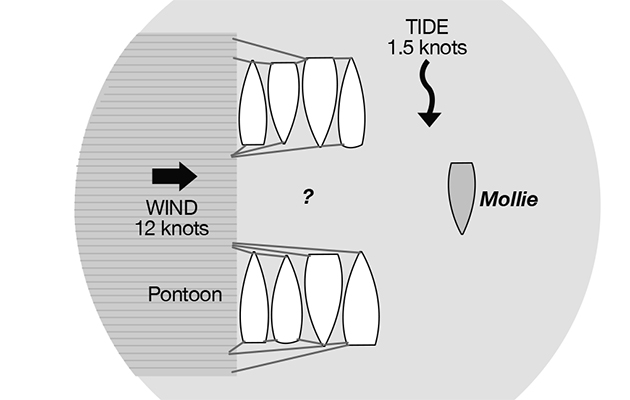With a 1.5 knot tide flowing and 12 knot winds blowing straight off the pontoon, would you be confident to moor in a tight spot?
With a 1.5 knot tide running and the wind blowing straight off the pontoon at 12 knots, how confident would you be to moor on a busy pontoon?
James Stevens answers your Questions of Seamanship.
Question: Could you moor on a very busy pontoon?
John and Mary own Mollie, a Twister, which is a long-keeled sturdy 8.5m yacht.
Mollie manoeuvres ahead under power without too much trouble, but being long-keeled John and Mary reckon she always goes astern towards the nearest hazard.
Their intention is to moor on a pontoon up the river where they can walk ashore to a favourite pub for an evening meal.
When they arrive there are already eight yachts on the pontoon in two rafts of four each.

It is clearly a club rally as they are all flying the same burgee and their crews must already be in the pub as there does not appear to be anyone on board.
John and Mary are pretty frustrated that there is hardly any space left on the pontoon for Mollie and the harbour rules say that yachts cannot raft up more than four abreast.
If only the club members had moved the rafts closer together there would be plenty of room for Mollie on the end.
There is, however, a gap between the rafts which John and Mary reckon is about 10m wide, just enough to squeeze Mollie in.
There is a 1.5 knot tide flowing and the wind is unhelpfully blowing straight off the pontoon at about 12 knots.
John and Mary look at the gap.
Should they attempt it or find a different mooring?
James Stevens answers:
It requires very careful handling and a technique known as ferry gliding.
In this situation the strong tide is going to be the force that moves Mollie towards the pontoon, cancelling out the offshore wind.
It is vital to attempt the manoeuvre before slack water.
First, once the fenders and warps have been prepared, Mollie should be positioned head-to-tide just outside the gap.
Continues below…
How to raft up safely and securely
James Stevens looks at the seamanship and etiquette needed to raft up and identifies the benefits and pitfalls of coming…
Could you berth safely in a strong cross wind?
Do you panic when trying to berth in a busy marina? How would you cope with strong cross wind? James…
An expert guide to box berthing
Dutch boatbuilder Eeuwe Kooi has been box berthing all his life. He shows Chris Beeson how the pros do it
The trick here is to control the throttle carefully to maintain speed through the water, but not over the ground.
The best way to check this is to line up a transit ashore.

James Stevens, author of the Yachtmaster Handbook, spent 10 years as the RYA’s Training Manager and Yachtmaster Chief Examiner
It will require carefully engaging and disengaging the propeller.
The helm should then be slowly steered towards the gap.
If there is too much boat speed or the helm movement is too much Mollie will end up alongside the downtide raft pinned on by the tide.
With very small helm movements and skilled use of the engine Mollie can be eased into the gap pointing into the tide.
There is a big temptation to go too quickly for the pontoon but it is much safer to take it slowly and safely.
Surrounded by two rafts of boats is not a place for beginners to practise tricky boat handling so I recommend only experienced sailors attempt this technique.
For all the latest from the sailing world, follow our social media channels Facebook, Twitter and Instagram.
Have you thought about taking out a subscription to Yachting Monthly magazine?
Subscriptions are available in both print and digital editions through our official online shop Magazines Direct and all postage and delivery costs are included.
- Yachting Monthly is packed with all the information you need to help you get the most from your time on the water.
- Take your seamanship to the next level with tips, advice and skills from our expert skippers and sailors
- Impartial in-depth reviews of the latest yachts and equipment will ensure you buy the best whatever your budget
- If you are looking to cruise away with friends Yachting Monthly will give you plenty of ideas of where to sail and anchor







